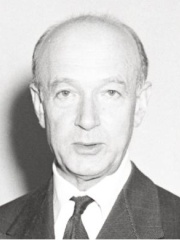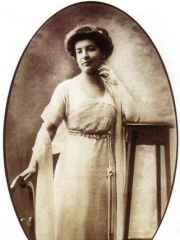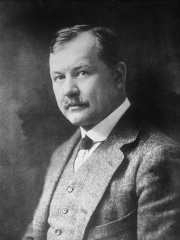
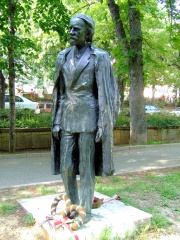
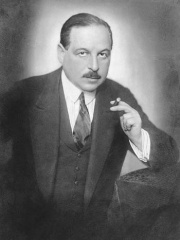
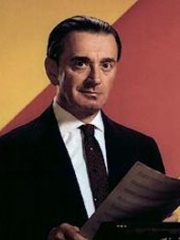
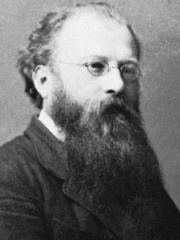
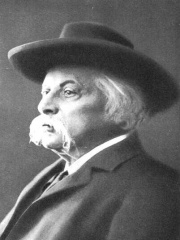
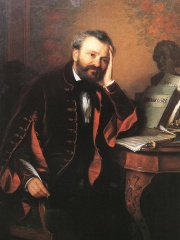
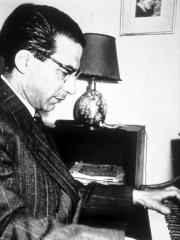
The Most Famous
COMPOSERS from Hungary
Top 10
The following people are considered by Pantheon to be the top 10 most legendary Hungarian Composers of all time. This list of famous Hungarian Composers is sorted by HPI (Historical Popularity Index), a metric that aggregates information on a biography's online popularity. Visit the rankings page to view the entire list of Hungarian Composers.

1. Franz Lehár (1870 - 1948)
With an HPI of 76.92, Franz Lehár is the most famous Hungarian Composer. His biography has been translated into 49 different languages on wikipedia.
Franz Lehár ( LAY-har; Hungarian: Lehár Ferenc [ˈlɛhaːr ˈfɛrɛnt͡s]; 30 April 1870 – 24 October 1948) was an Austro-Hungarian composer. He is mainly known for his operettas, of which the most successful and best known is The Merry Widow (Die lustige Witwe).

2. Zoltán Kodály (1882 - 1967)
With an HPI of 74.36, Zoltán Kodály is the 2nd most famous Hungarian Composer. His biography has been translated into 49 different languages.
Zoltán Kodály (UK: , US: ; Hungarian: Kodály Zoltán, pronounced [ˈkodaːj ˈzoltaːn]; 16 December 1882 – 6 March 1967) was a Hungarian composer, ethnomusicologist, music pedagogue, linguist, and philosopher. He is well known internationally as the creator of the Kodály method of music education.

3. Emmerich Kálmán (1882 - 1953)
With an HPI of 73.97, Emmerich Kálmán is the 3rd most famous Hungarian Composer. His biography has been translated into 41 different languages.
Emmerich Kálmán (Hungarian: Kálmán Imre [ˈkaːlmaːn ˈimrɛ]; 24 October 1882 – 30 October 1953) was a Hungarian composer of operettas and a prominent figure in the development of Viennese operetta in the 20th century. Among his most popular works are Die Csárdásfürstin (1915) and Gräfin Mariza (1924). Influences on his compositional style include Hungarian folk music (such as the csárdás), the Viennese style of precursors such as Johann Strauss II and Franz Lehár, and, in his later works, American jazz. As a result of the Anschluss, Kálmán and his family fled to Paris and then to the United States. He eventually returned to Europe in 1949 and died in Paris in 1953.

4. Miklós Rózsa (1907 - 1995)
With an HPI of 67.91, Miklós Rózsa is the 4th most famous Hungarian Composer. His biography has been translated into 44 different languages.
Miklós Rózsa (Hungarian: [ˈmikloːʃ ˈroːʒɒ]; April 18, 1907 – July 27, 1995) was a Hungarian-American composer trained in Germany (1925–1931) and active in France (1931–1935), the United Kingdom (1935–1940), and the United States (1940–1995), with extensive sojourns in Italy from 1953 onward. Best known for his nearly one hundred film scores, he nevertheless maintained a steadfast allegiance to absolute concert music throughout what he called his "double life". Rózsa achieved early success in Europe with his orchestral Theme, Variations, and Finale (Op. 13) of 1933, and became prominent in the film industry from such early scores as The Four Feathers (1939) and The Thief of Bagdad (1940). The latter project brought him to Hollywood when production was transferred from wartime Britain, and Rózsa remained in the United States, becoming an American citizen in 1946. During his Hollywood career, he received 17 Academy Award nominations including three Oscars for Spellbound (1945), A Double Life (1947), and Ben-Hur (1959), while his concert works were championed by such major artists as Jascha Heifetz, Gregor Piatigorsky, and János Starker.
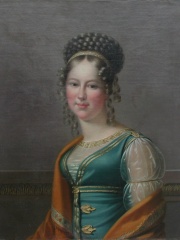
5. Princess Maria Antonia Koháry (1797 - 1862)
With an HPI of 67.58, Princess Maria Antonia Koháry is the 5th most famous Hungarian Composer. Her biography has been translated into 21 different languages.
Princess Mária Antónia Gabriella Koháry de Csábrág et Szitnya (Hungarian: csábrági és szitnyai herceg Koháry Mária Antónia Gabriella; 2 July 1797 – 25 September 1862) was a Hungarian noblewoman and the ancestor of several European monarchs. She was the sole heiress of the House of Koháry, which belonged to one of the three largest landowners in Hungary.

6. Hans Richter (1843 - 1916)
With an HPI of 66.11, Hans Richter is the 6th most famous Hungarian Composer. His biography has been translated into 27 different languages.
Johann Baptist Isidor Richter (Hungarian: Richter János Isidor; 4 April 1843 – 5 December 1916) was an Austro-Hungarian orchestral and operatic conductor.

7. Karl Goldmark (1830 - 1915)
With an HPI of 65.37, Karl Goldmark is the 7th most famous Hungarian Composer. His biography has been translated into 27 different languages.
Karl Goldmark (born Károly Goldmark, Keszthely, 18 May 1830 – Vienna, 2 January 1915) was a Hungarian-born Viennese composer.

8. Ferenc Erkel (1810 - 1893)
With an HPI of 64.38, Ferenc Erkel is the 8th most famous Hungarian Composer. His biography has been translated into 35 different languages.
Ferenc Erkel (Hungarian: Erkel Ferenc Hungarian pronunciation: [ˈɛrkɛl ˈfɛrɛnt͡s], German: Franz Erkel; November 7, 1810 – June 15, 1893) was a Hungarian composer, conductor and pianist. He was the father of Hungarian grand opera, written mainly on historical themes, which are still often performed in Hungary. He also composed the music of "Himnusz", the national anthem of Hungary, which was adopted in 1844. He died in Budapest.

9. Joseph Kosma (1905 - 1969)
With an HPI of 63.81, Joseph Kosma is the 9th most famous Hungarian Composer. His biography has been translated into 25 different languages.
Joseph Kosma (22 October 1905 – 7 August 1969) was a Hungarian composer who immigrated to France. His most famous composition is the standard Autumn Leaves.
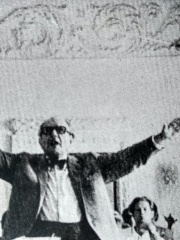
10. Hans Swarowsky (1899 - 1975)
With an HPI of 63.41, Hans Swarowsky is the 10th most famous Hungarian Composer. His biography has been translated into 21 different languages.
Hans Swarowsky (September 16, 1899 – September 10, 1975) was an Austrian conductor of Hungarian birth. Swarowsky was born in Budapest, Hungary. He studied the art of conducting under Felix Weingartner and Richard Strauss. His teachers in musical theory included Arnold Schoenberg and Anton Webern. Herbert von Karajan invited him to take on the permanent position as conductor of the Vienna State Opera. He became a professor of conducting at the Vienna Music Academy. His many conducting students included Claudio Abbado, Mariss Jansons, Alexis Hauser, Alexander Alexeev, Zubin Mehta, Leonid Nikolaev, Paul Angerer, Ádám and Iván Fischer, Avi Ostrowsky Jesús López-Cobos, Gustav Meier, Ewa Michnik, Miltiades Caridis, Aleksandr Alekseyev, Giuseppe Sinopoli, Gianluigi Gelmetti, Brian Jackson, Alfred Prinz, Bryan Fairfax, James Allen Gähres, Albert Rosen and Bruno Weil,Wolfgang Harrer. Otmar Suitner was Hans Swarowsky's successor at the Vienna Music Academy. Swarowsky's lectures and essays were collected into the publication Wahrung der Gestalt (Keeping Shape), which today serves as an encyclopaedia for performance and conducting. From 1957 to 1959 he was chief conductor of the Scottish National Orchestra (now the Royal Scottish N.O.). He died in Salzburg, Austria, less than a week before his 76th birthday.
People
Pantheon has 17 people classified as Hungarian composers born between 1797 and 1929. Of these 17, none of them are still alive today. The most famous deceased Hungarian composers include Franz Lehár, Zoltán Kodály, and Emmerich Kálmán.
Deceased Hungarian Composers
Go to all RankingsFranz Lehár
1870 - 1948
HPI: 76.92
Zoltán Kodály
1882 - 1967
HPI: 74.36
Emmerich Kálmán
1882 - 1953
HPI: 73.97
Miklós Rózsa
1907 - 1995
HPI: 67.91
Princess Maria Antonia Koháry
1797 - 1862
HPI: 67.58
Hans Richter
1843 - 1916
HPI: 66.11
Karl Goldmark
1830 - 1915
HPI: 65.37
Ferenc Erkel
1810 - 1893
HPI: 64.38
Joseph Kosma
1905 - 1969
HPI: 63.81
Hans Swarowsky
1899 - 1975
HPI: 63.41
Joseph Szigeti
1892 - 1973
HPI: 63.05
Dora Pejačević
1885 - 1923
HPI: 62.98
Overlapping Lives
Which Composers were alive at the same time? This visualization shows the lifespans of the 17 most globally memorable Composers since 1700.

